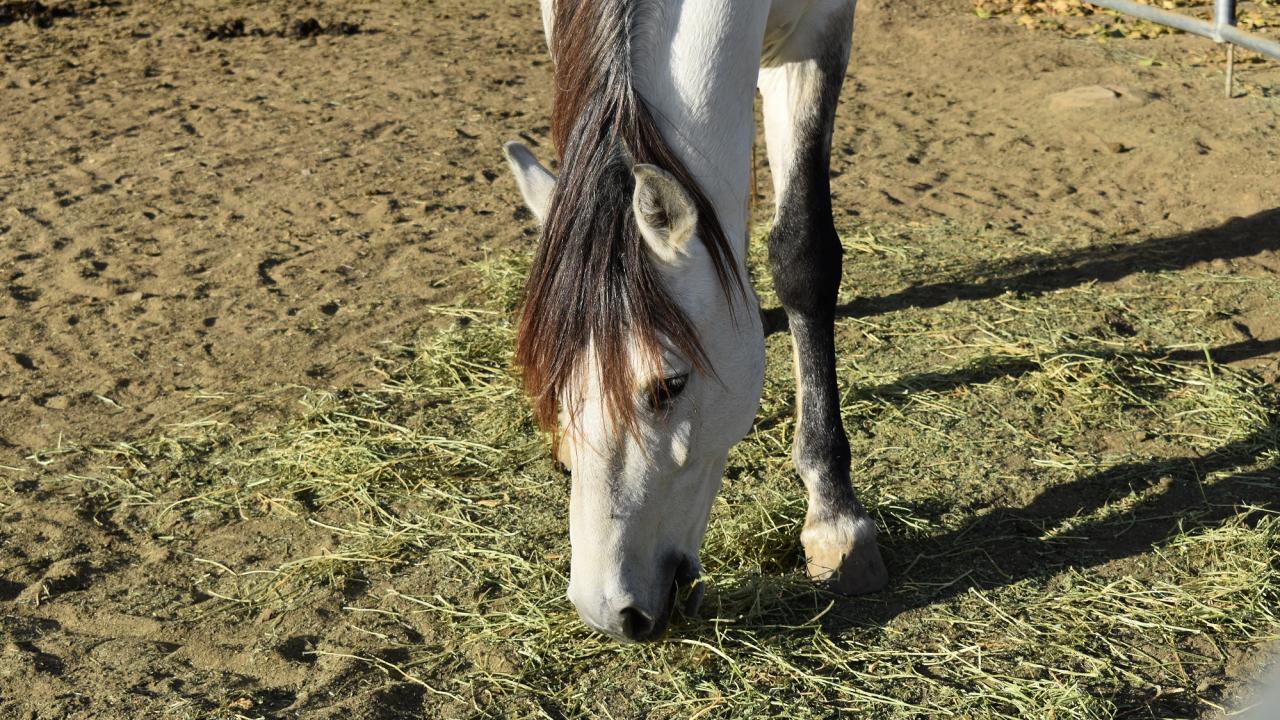
Esophageal Obstruction (Choke) in Horses
What is choke?
Takeaways
- Esophageal obstruction, or choke, is a common equine emergency.
- It can occur when food or objects block the esophagus.
- The most common clinical sign of choke in horses is green discharge from the nose.
- Some cases of choke resolve on their own. Others require veterinary intervention.
- Call your veterinarian immediately if you notice signs of choke in your horse.
Esophageal obstruction, also known as choke, is common in horses. It occurs when food or foreign objects block the muscular tube that carries food from the mouth to the stomach (the esophagus). The obstruction can be caused by rapid ingestion of feed material (bolting), improper chewing due to dental disease, swallowing a foreign body, inadequate water intake, eating when heavily sedated, or the presence of esophageal disease such as megaesophagus, abscesses, cysts, and other conditions.
Studies have shown that Friesians have a higher prevalence of esophageal disease, particularly meagaesophagus, than other breeds. This can make them predisposed to choke. Anecdotally, American Miniature Horses are also overrepresented among cases of choke.
One of the most common complications from choke is aspiration pneumonia, which develops when feed material and saliva make their way into the lungs, causing secondary bacterial infections. The longer the obstruction is present, the higher the risk of aspiration pneumonia.
Another potential complication from choke is trauma to the esophagus. This can range from mild (ulceration) to severe (perforation).
It is important to note that horses can choke on a variety of feedstuffs and treats, especially if they are prone to eating rapidly. Although it is a common belief that beet pulp causes choke, research has shown that it is no more likely to cause choke than other types of feed.
What are the clinical signs of choke?
Choke is usually characterized by nasal discharge that contains saliva and food. This often appears as a green, frothy discharge from the nostrils. Other clinical signs may include excessive salivation, coughing, gulping, trouble swallowing, sweating, extension of the head and neck after eating, and restlessness.
Choke is a serious condition that can result in life-threatening complications. Contact your veterinarian if you think your horse may be choking. While you are waiting for them to arrive, keep your horse as calm as possible. Do not let your horse eat as this can worsen the obstruction and do not attempt to resolve the choke yourself.
How is choke diagnosed?
Choke is diagnosed based on clinical signs and physical examination, including an oral examination. A nasogastric tube may be passed to determine the location of the obstruction. Additional diagnostic tools such as endoscopy, ultrasound, and radiography may be required for more complicated or recurring cases.
How is choke treated?
Some cases of choke in horses resolve on their own, especially if the horse is sedated since sedation promotes relaxation of the esophagus and other muscles. Medical management of choke is focused on removing the obstruction while minimizing potential trauma to the esophagus and preventing aspiration pneumonia. Esophageal lavage(s) with warm water are often used to break up the impaction. Broad spectrum antibiotics may be prescribed for cases with aspiration pneumonia.
Esophageal obstructions may require surgery under general anesthesia in severe cases, but surgical management is rare and carries a high incidence of complications.
Affected horses may need to remain off their normal feed for a day or more after the choke is resolved. Feed should then be reintroduced gradually per your veterinarian’s instructions. A wet pelleted feed is typically offered before forage because it is gentler on the esophagus. Horses that experience recurrence of choke may require permanent dietary modifications.
What is the prognosis for choke?
The prognosis for choke is generally good in cases of simple esophageal impaction that are first-time occurrences with no associated complications. The prognosis is often poor for cases in which the obstruction is due to functional or morphological abnormalities and cases that experience complications.
How can choke be prevented?
Horse owners can help prevent choke by:
- Ensuring that dry feedstuffs are soaked properly and that carrots, apples and other treats are portioned appropriately.
- Ensuring that clean, fresh water is available at all times.
- Feeding in haynets, spreading feed out over a larger area, or utilizing slow-feed toys to keep horses from bolting their food.
- Providing multiple buckets or piles of food for horses that live in herds so less dominant individuals do not feel forced to eat quickly.
- Having a veterinarian perform regular oral examinations to identify dental issues.
It is difficult to prevent choke in horses that become affected due to anatomical problems or diseases. Avoiding recurring incidents may require veterinary interventions such as advanced diagnostics and surgery.
For more information
Understanding Choke in Horses, AAEP https://aaep.org/horsehealth/understanding-choke-horses
*This article may not be reproduced without the written consent of the UC Davis Center for Equine Health. Please email requests to cehadmin@ucdavis.edu.
